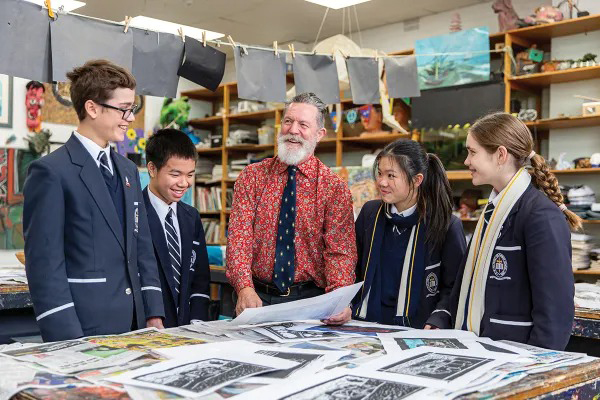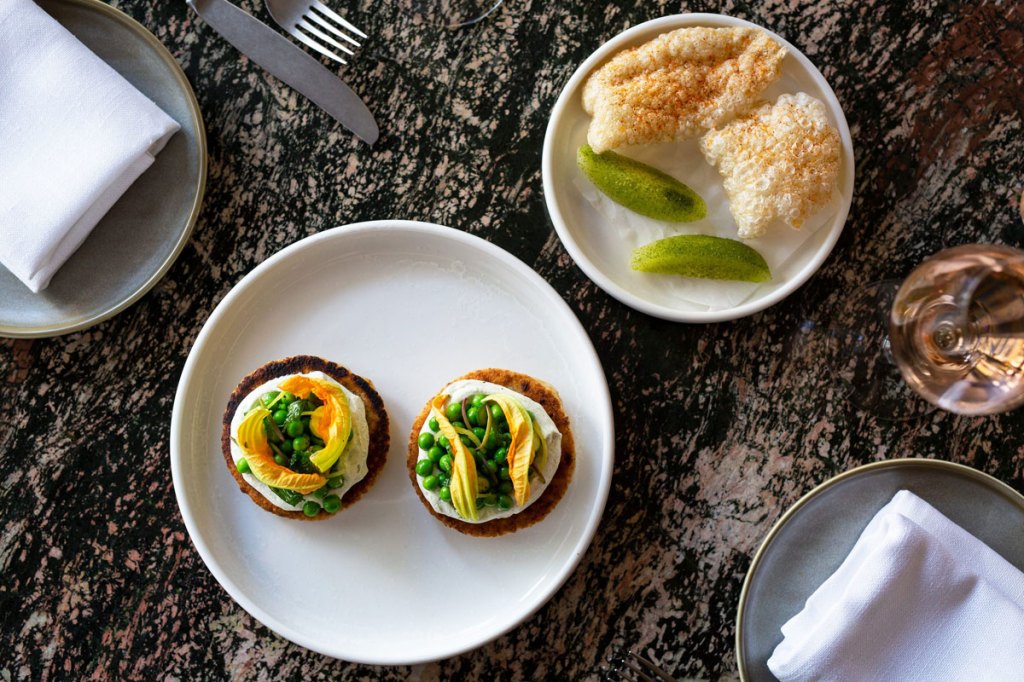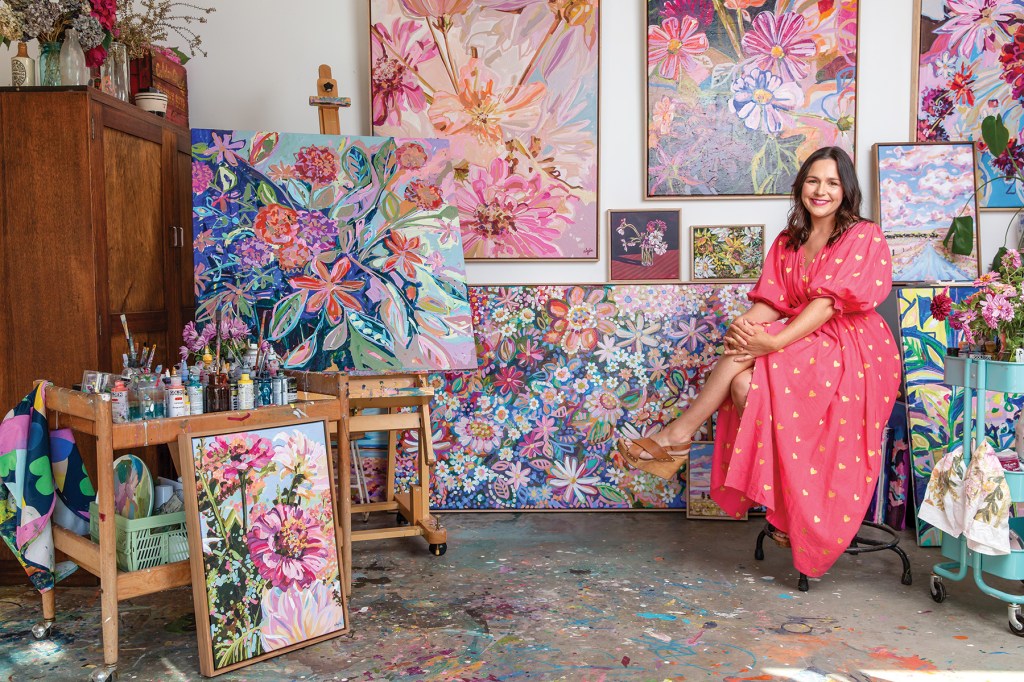Pulteney Grammar School has been celebrating the colourful legacy of art teacher Rod James. Rod is set to retire after more than three decades educating and inspiring Pulteney’s young minds with creativity, a sense of adventure and the courage to be themselves.
Rod James’s artistic practice is all about flow. There’s no agonising over a piece for hours or days until the creativity stagnates. He paints in the moment while the inspiration is fresh. It means he’s usually able to complete a piece of artwork in about the same the time it takes to teach one or two of his art classes at Pulteney Grammar School.
It’s an efficient approach Rod has developed during his 36 years of teaching art and design at the South Terrace school, where he’s encouraged students to overcome perfectionism and empowered them to boldly create art for themselves, not for someone else.
“When I started in art school, I was worried about what other people would think of my work,” Rod says. “Whereas now, I paint for myself. It’s been about becoming more expressive, confident, and less worried about what other people think. I remember meeting (artist) David Bromley and he said to me: ‘One thing I’ve decided is not to care what people think about my paintings’.
“For me, art’s better when it’s fresh. I won’t agonise over it. You sit there for an hour-and-a-half and do your painting, feel really good about it, have a cup of tea, and go and do something else. You’ve got to seize the day and not become too bogged down with details. That’s how I’ve always seen things.”
This approach to art – and life – has enabled Rod to look at the world with a sense of childlike wonder, even on the cusp of retirement. His gregarious attitude, dad jokes and open-studio policy have made him a much-loved figure at Pulteney Grammar, where generations of students have sat in his classroom.
“Here I am at 67 and I just love each day,” says Rod. “I love making art with the students. I look back and think that it was a different era when I started. The importance of the subject of art has become better respected over the years.”

A painting by his daughter Isabella James
However, when Rod himself was a student, he struggled with schooling. Sadly, by the age of 11, he had lost both of his parents to health conditions. He was raised by his elder sister Jen, who went on to become an interior designer, and her husband David Griggs, an actor. Growing up with them meant there were always creative people around, and Rod’s grandfather Norman Potter was a successful illustrator.
You might like
“I struggled with academic subjects, but art was my release, and I was inspired by the creativity in my family around me,” says Rod, who believes he might have been diagnosed with dyslexia, had it been better understood back then.
“Kids are much better supported these days, which is awesome. That has changed a lot over the past 30 years. Art was something I could walk away feeling good about, knowing that I’d achieved something.
“As a kid, after losing my parents, I got into building a big model railway and that was a great escape for me. That was important.”
Rod’s experience as a struggling student has enabled him to connect with his students who are experiencing similar challenges. “I was one of the struggling kids at school, so I can relate to them,” he says.
“You have kids who might be really struggling or frustrated with school, and they come over to art and after a while, they become so absorbed in it, and they just love it. I see art as a wellbeing practice. Students can get stressed about other subjects, but then they come over to art and they feel at home; there are no right or wrong answers.

Rod in his home studio.
“They feel so relaxed while they’re working on their paintings and talking with their friends, and they can just totally be themselves, which is a really nice thing, and not something you can do in every subject.”
Rod didn’t know what he wanted to do when he left school. He studied art for several years and became a substitute teacher, but felt as if it just wasn’t for him. He left teaching to take up a job as a gardener at the Adelaide Zoo. Before long, Rod was designing the landscaping for the animal enclosures.
“I loved my time landscaping at the zoo, and since then a mate and I landscaped a big property on 20 acres in the Adelaide Hills. Landscaping is like three-dimensional sculptural art, only on a bigger plane. Creativity can take so many forms,” he says.
Rod decided to give teaching another go, and found his place at Pulteney Grammar School, where he thrived. “When I was a young man, I was still building my confidence. I realised over time that I loved being with people and communicating, and I liked the creativity of young people,” he says.
“I found my niche in art and design, and I’ve taught thousands of kids over the years, it’s been great. The most satisfaction comes from teaching kids who maybe aren’t always connected when they first come into art, but you see them begin to really love what they’re doing.”
Subscribe for updates
Although he’s worked across countless media, Rod particularly loves painting in nature – en plein air. Many of his landscapes are inspired by Kangaroo Island where he and his wife Keryn have a holiday home. About once a month, Rod joins his daughter Isabella for a drive in her Kombi van up to the Adelaide Hills where they find a picturesque spot to set up their easels and paint for an hour or two.

Rod has produced art in a multitude of media throughout his career.
“I just love the process, the smell of the paint,” Rod says. “Every time Isy and I do a painting, we try to challenge ourselves. Sometimes it goes really well, other times not, and I love the challenge of that. We’ve got a shack on Kangaroo Island where Keryn and I find a lot of inspiration, and our children have too.
“I have been hugely supported by Keryn, Isabella and Henry. They have always encouraged me to be myself and create to my heart’s content. Without them I would not be nearly as inspired.”
In turn, Rod has inspired both of his children, Isabella having become a landscape architect and amateur artist, and his son Henry is a primary school teacher.
The stereotype of an artist is often of someone who hides away in a studio, spending hours toiling in solitude, but Rod is very social and enjoys being around others while creating. He often creates lino block prints at the kitchen table, so he can be close to his family. His block prints are most often recreations of family photos or memories, many of which adorn the wall in his lounge room.
“I like to create expressive, creative pieces, but I like to keep busy with a lot of other things in my life – I like to do a bit of gardening, fixing up cars, and I have an old boat that I’m working on too, so I don’t want to spend all of my time doing art.”

Rod plans to formally retire at the end of the year, but hopes to teach part-time.
“I’ve got so many projects to do,” he says. “I may do a bit of part-time teaching at school, just because I love it so much, and run art workshops in the future. When you’ve been doing something that you love for so long, it’s hard to just walk away.”
For those who want to procure a Rod James piece to hang on their wall at home, well, you need only ask. “I love art for wellbeing, not as a monetary thing,” says Rod. “I’ve had old scholars say they’d love to buy one of my artworks, and I say ‘Well, you don’t need to buy it – I’ve got a couple of paintings here, you can have one’.”
The exhibition Rod James: A Retrospective is on display for the South Australian Living Artists Festival, at Pulteney Grammar School’s Osmond Street Cafe, until August 31.
This article first appeared in the August 2024 issue of SALIFE magazine.





